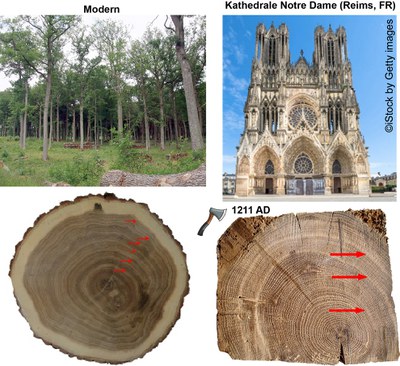Research foci
Societal change and forest management
Humans and forests over the millennia: We analyse the changing societal demands placed on forests and examine historical forest management practices based on existing or transformed forest stands, historical documents, tree ring patterns, and historical wood findings.

Change in the growth pattern of a modern (left, six times) and historical (right, 3 times) oak due to coppicing (coppice-with-standard). The red arrows mark years with very narrow growth rings caused by competition for resources with the undergrowth. Rapid growth follows the removal of the undergrowth (so-called release effects) (Photos: W. Tegel).
Historical timber utilisation
Everything related to the history of construction and woodworking: Using archaeological methods on timber for construction and artworks, as well as historical documents such as records and photographs, we decode the specific wood species selection, wood usage, timber trade, and architectural practices of the past.

Panel painting from Rubens' studio: Two Head Studies of Monks (Private Collection, UK) (left), Panel makers and marks of the branding iron from the Guild of St Luke (two hands over Antwerp Castle) (centre) and the written petition of the panel makers and mirror case makers dated 3 November 1617 (right) (Jordaens Van Dyck Journal I & III).
Society and environmental perception
Relationship between Humans and Forests in a Social Scientific Context: We explore the cultural significance of the forest in society, captured in myths, tales and traditions, as well as the social, economic and political power structures that have influenced access to forest resources and created inequalities (through expectations). Based on theories from social sciences, we examine how forests have been integrated into social, economic and political processes by using historical sources and statistical analysis.

Five women sitting at the edge of a forest with bundles of firewood on their backs [photo: Rudolf (unspecified) (from Kleinschmit (2007), p. 38) (left). A wolf attacks children in the forest (from ‘Johann Staub's picture book: Anschauungsunterricht für Kinder’ from 1917) (right).

